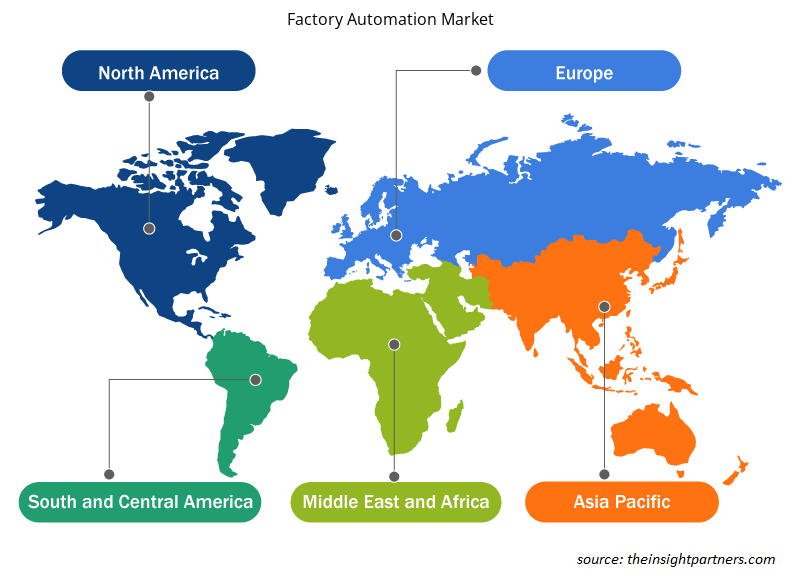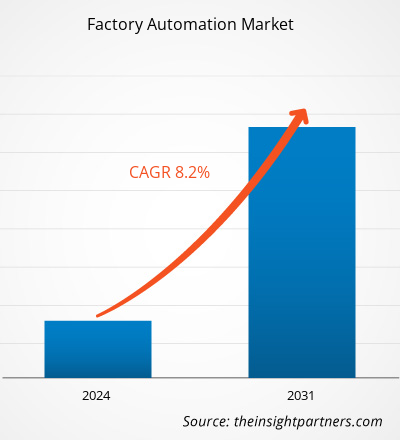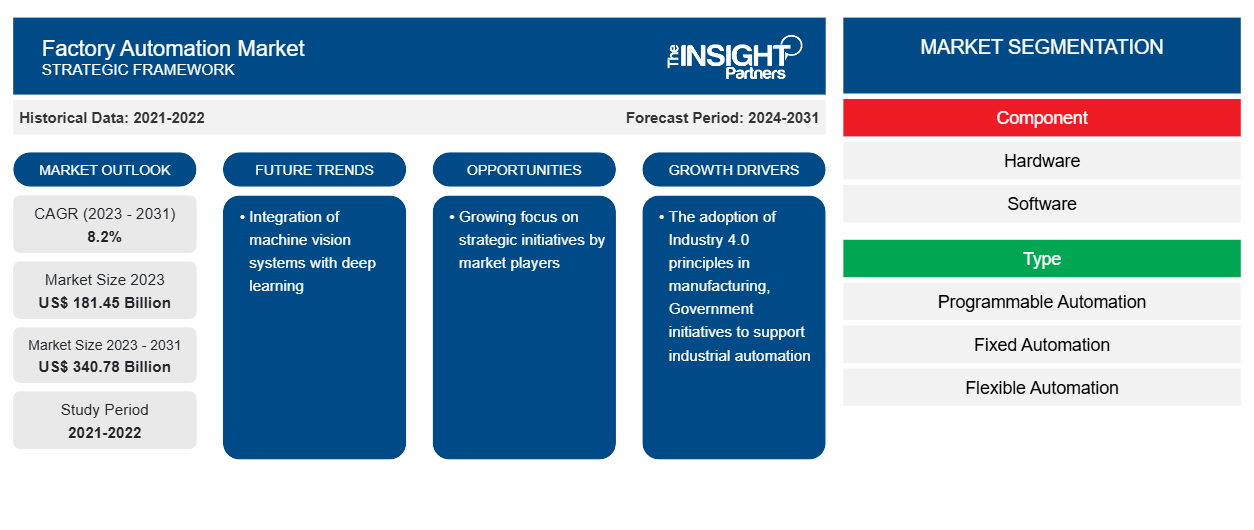Der Markt für Fabrikautomatisierung soll von 181,45 Milliarden US-Dollar im Jahr 2023 auf 340,78 Milliarden US-Dollar im Jahr 2031 wachsen; von 2023 bis 2031 wird eine durchschnittliche jährliche Wachstumsrate von 8,2 % erwartet. Die Integration von Bildverarbeitungssystemen mit Deep Learning wird voraussichtlich ein wichtiger Trend auf dem Markt sein.
Fabrikautomation Marktanalyse
Das Fertigungsgeschäft hat im letzten Jahrzehnt rasant zugenommen. Die Globalisierung erweitert den Markt und zieht eine große Zahl neuer Akteure an. Wettbewerbsvorteile auf dem Markt für Fabrikautomation können für wichtige Unternehmen durch Produktdifferenzierung, Kostenführerschaft, zielgerichtetes Marketing und hervorragenden Kundendienst erzielt werden. Automatisierung ist ein entscheidender Faktor für Produktionsprozesse. Darüber hinaus ermöglichen fortschrittliche Automatisierungslösungen eine gleichbleibend hohe Qualität, einen hohen Durchsatz und niedrige Produktionskosten. Daher wird erwartet, dass der Markt für Fabrikautomation im Prognosezeitraum wachsen wird.
Branchenübersicht zum Fabrikautomatisierungsmarkt
Fabrikautomatisierung ist die Integration der Automatisierung in alle Phasen des Herstellungsprozesses. Bei der Automatisierung in der Fertigung werden häufig Technologien wie pneumatische Systeme , hydraulische Systeme und Roboterarme kombiniert, um ein komplexeres System zu schaffen. In einem wettbewerbsorientierten Umfeld kann die Fabrikautomatisierung dazu beitragen, die Leistung und Effizienz zu steigern und gleichzeitig die Kosten zu senken. Die Fabrikautomatisierung bietet eine überzeugende Methode, um Effizienz, Qualität, Nachhaltigkeit, Sicherheit und Schutz in einer sich schnell verändernden modernen Fabrikumgebung zu steigern.
Passen Sie diesen Bericht Ihren Anforderungen an
Sie erhalten kostenlos individuelle Anpassungen an jedem Bericht, einschließlich Teilen dieses Berichts oder einer Analyse auf Länderebene, eines Excel-Datenpakets sowie tolle Angebote und Rabatte für Start-ups und Universitäten.
- Holen Sie sich die wichtigsten Markttrends aus diesem Bericht.Dieses KOSTENLOSE Beispiel umfasst eine Datenanalyse von Markttrends bis hin zu Schätzungen und Prognosen.
Markttreiber und Chancen für die Fabrikautomatisierung
Einführung des Industrie 4.0-Prinzips in der Fertigung zur Förderung des Marktwachstums.
Die revolutionäre Kraft der vierten industriellen Revolution (Industrie 4.0) verändert die globale Produktion. Industrie 4.0, die (teilweise) durch intelligente Systeme, künstliche Intelligenz (KI), Big Data und fortschrittliche IT-Architektur definiert ist, stellt den nächsten Schritt in der Entwicklung der gesamten Fertigung dar, und viele Unternehmen übernehmen diese Technologien. Zu den Vorteilen der Prozesse, Technologien und Systeme von Industrie 4.0 gehören verbesserte Produktivität und Effizienz, bessere Agilität und Flexibilität sowie höhere Rentabilität. Daher wird erwartet, dass die Einführung von Industrie 4.0 für die Automatisierung in zahlreichen Branchen das Wachstum des Marktes für Fabrikautomatisierung im Prognosezeitraum ankurbeln wird.
Strategische Initiativen der Marktteilnehmer rücken zunehmend in den Fokus
Der wachsende Fokus wichtiger Marktteilnehmer auf strategische Aktivitäten wie Fusionen, Übernahmen und Kooperationen dürfte das Wachstum des Marktes für Fabrikautomation ankurbeln. So gab Rockwell Automation, Inc., ein Unternehmen, das sich mit industrieller Automatisierung und digitaler Transformation beschäftigt, im Juli 2021 die Übernahme von Plex Systems bekannt, der führenden Cloud-nativen Smart-Manufacturing-Plattform. Darüber hinaus kündigte Rockwell Automation, Inc. im September 2021 eine Partnerschaft mit Kezzler an, einer cloudbasierten Plattform für Produktdigitalisierung und -rückverfolgung, um Herstellern dabei zu helfen, den Weg ihrer Produkte von den Rohstoffquellen bis zur Verkaufsstelle oder darüber hinaus mithilfe cloudbasierter Lieferkettenlösungen mit Schwerpunkt auf Produktrückverfolgbarkeit zu erfassen.
Segmentierungsanalyse des Fabrikautomatisierungsmarktberichts
Die Schlüsselsegmente, die zur Ableitung der Marktanalyse für Fabrikautomatisierung beigetragen haben , sind Komponente, Typ, Technologie und Branche.
- Basierend auf den Komponenten ist der Markt in Hardware und Software unterteilt
- Auf der Grundlage des Typs ist der Markt in programmierbare Automatisierung, feste Automatisierung und flexible Automatisierung unterteilt.
- Basierend auf der Technologie ist der Markt in speicherprogrammierbare Steuerungen (SPS), verteilte Steuerungssysteme (DCS), Überwachungssteuerungs- und Datenerfassungssysteme (SCADA), Mensch-Maschine-Schnittstellen (HMI) und andere unterteilt.
- Auf Grundlage der Branchenvertikale wird der Markt in die Branchen Automobil, Nahrungsmittel und Getränke, Öl und Gas, Fertigung, Bergbau und Sonstige unterteilt.
Fabrikautomatisierung Marktanteilsanalyse nach Geografie
Regional ist der Markt in Nordamerika, Europa, Asien-Pazifik, Naher Osten und Afrika sowie Süd- und Mittelamerika segmentiert.
Nordamerika wird im Prognosezeitraum voraussichtlich einen bedeutenden Anteil am Markt für Fabrikautomation halten. Dieses Wachstum ist auf die frühe Einführung neuer Technologien und eine starke Betonung von Forschungs- und Entwicklungsaktivitäten zurückzuführen. Darüber hinaus wird erwartet, dass die wachsende Popularität kollaborativer Roboter und staatlicher Initiativen zur digitalen Transformation in allen Branchen den Markt für Fabrikautomation im Prognosezeitraum ankurbeln werden.
Regionale Einblicke in den Fabrikautomatisierungsmarkt
Die regionalen Trends und Faktoren, die den Fabrikautomatisierungsmarkt im Prognosezeitraum beeinflussen, wurden von den Analysten von Insight Partners ausführlich erläutert. In diesem Abschnitt werden auch die Marktsegmente und die Geografie des Fabrikautomatisierungsmarkts in Nordamerika, Europa, im asiatisch-pazifischen Raum, im Nahen Osten und Afrika sowie in Süd- und Mittelamerika erörtert.

- Erhalten Sie regionale Daten zum Fabrikautomatisierungsmarkt
Umfang des Marktberichts zur Fabrikautomatisierung
| Berichtsattribut | Details |
|---|---|
| Marktgröße im Jahr 2023 | 181,45 Milliarden US-Dollar |
| Marktgröße bis 2031 | 340,78 Milliarden US-Dollar |
| Globale CAGR (2023 - 2031) | 8,2 % |
| Historische Daten | 2021-2022 |
| Prognosezeitraum | 2024–2031 |
| Abgedeckte Segmente | Nach Komponente
|
| Abgedeckte Regionen und Länder | Nordamerika
|
| Marktführer und wichtige Unternehmensprofile |
|
Dichte der Marktteilnehmer für Fabrikautomatisierung: Auswirkungen auf die Geschäftsdynamik verstehen
Der Markt für Fabrikautomation wächst rasant, angetrieben durch die steigende Nachfrage der Endnutzer aufgrund von Faktoren wie sich entwickelnden Verbraucherpräferenzen, technologischen Fortschritten und einem größeren Bewusstsein für die Vorteile des Produkts. Mit steigender Nachfrage erweitern Unternehmen ihr Angebot, entwickeln Innovationen, um die Bedürfnisse der Verbraucher zu erfüllen, und nutzen neue Trends, was das Marktwachstum weiter ankurbelt.
Die Marktteilnehmerdichte bezieht sich auf die Verteilung der Firmen oder Unternehmen, die in einem bestimmten Markt oder einer bestimmten Branche tätig sind. Sie gibt an, wie viele Wettbewerber (Marktteilnehmer) in einem bestimmten Marktraum im Verhältnis zu seiner Größe oder seinem gesamten Marktwert präsent sind.
Die wichtigsten auf dem Markt für Fabrikautomatisierung tätigen Unternehmen sind:
- ABB Ltd.
- Emerson Electric Co.
- Fanuc Corporation
- Allgemeine Elektrizit?tsgesellschaft
- Mitsubishi Electric Corporation
- Honeywell International Inc.
Haftungsausschluss : Die oben aufgeführten Unternehmen sind nicht in einer bestimmten Reihenfolge aufgeführt.

- Überblick über die wichtigsten Akteure auf dem Markt für Fabrikautomatisierung
Neuigkeiten und aktuelle Entwicklungen zum Fabrikautomatisierungsmarkt
Der Markt für Fabrikautomation wird durch die Erhebung qualitativer und quantitativer Daten nach Primär- und Sekundärforschung bewertet, die wichtige Unternehmenspublikationen, Verbandsdaten und Datenbanken umfasst. Nachfolgend sind einige der Entwicklungen in der Fabrikautomation aufgeführt:
- Mitsubishi Electric Corporation gab bekannt, dass es rund 2,2 Milliarden indische Rupien oder 3,1 Milliarden Yen in seine Tochtergesellschaft Mitsubishi Electric India Pvt. Ltd. investieren wird, um eine neue Fabrik in Indien zu errichten. Die neue Fabrik soll im Dezember 2023 ihren Betrieb aufnehmen und Wechselrichter und andere Steuerungssysteme für die Fabrikautomation (FA) herstellen. Damit erweitert das Unternehmen seine Kapazitäten, um der wachsenden Nachfrage in Indien gerecht zu werden. (Quelle: Mitsubishi Electric Corporation, Pressemitteilung, Juni 2022)
Bericht zum Markt für Fabrikautomatisierung – Abdeckung und Ergebnisse
Die Prognose des Fabrikautomatisierungsmarktes wird auf der Grundlage verschiedener sekundärer und primärer Forschungsergebnisse wie wichtiger Unternehmenspublikationen, Verbandsdaten und Datenbanken geschätzt. Der Marktbericht „Fabrikautomatisierungsmarktgröße und -prognose (2021–2031)“ bietet eine detaillierte Analyse des Marktes, die die folgenden Bereiche abdeckt:
- Größe und Prognose des Fabrikautomatisierungsmarktes auf globaler, regionaler und Länderebene für alle wichtigen Marktsegmente, die im Rahmen des Berichts abgedeckt sind
- Markttrends in der Fabrikautomatisierung sowie Marktdynamik wie Treiber, Einschränkungen und wichtige Chancen
- Detaillierte PEST/Porters Five Forces- und SWOT-Analyse
- Analyse des Fabrikautomatisierungsmarktes mit Blick auf wichtige Markttrends, globale und regionale Rahmenbedingungen, wichtige Akteure, Vorschriften und aktuelle Marktentwicklungen
- Branchenlandschaft und Wettbewerbsanalyse, die die Marktkonzentration, Heatmap-Analyse, prominente Akteure und aktuelle Entwicklungen auf dem Markt für Fabrikautomation umfasst
- Detaillierte Firmenprofile.
- Historische Analyse (2 Jahre), Basisjahr, Prognose (7 Jahre) mit CAGR
- PEST- und SWOT-Analyse
- Marktgröße Wert/Volumen – Global, Regional, Land
- Branchen- und Wettbewerbslandschaft
- Excel-Datensatz
Aktuelle Berichte
Erfahrungsberichte
Grund zum Kauf
- Fundierte Entscheidungsfindung
- Marktdynamik verstehen
- Wettbewerbsanalyse
- Kundeneinblicke
- Marktprognosen
- Risikominimierung
- Strategische Planung
- Investitionsbegründung
- Identifizierung neuer Märkte
- Verbesserung von Marketingstrategien
- Steigerung der Betriebseffizienz
- Anpassung an regulatorische Trends























 Kostenlose Probe anfordern für - Markt für Fabrikautomatisierung
Kostenlose Probe anfordern für - Markt für Fabrikautomatisierung